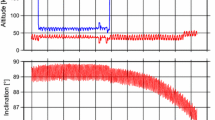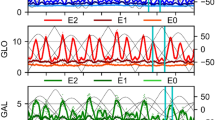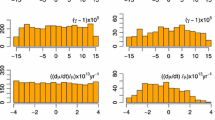Abstract
We used the INPOP19a planetary ephemerides to perform the orbital adjustment of 14099 asteroids based on Gaia-DR2 observations and compare for 23 of them the resulting orbits to radar data. As Gaia-DR2 has been processed using the planetary ephemeris INPOP10e, the primary goal of this paper is to confirm the portability of the data when using an updated version of the solar system model. In particular, we point out the fact that the Gaia satellite positions—provided with respect to the INPOP10e solar system barycenter—must be corrected when using another planetary ephemeris. We also present a convenient least square formalism that only handles small matrices and allows the adjustment of global parameters, such as masses. In order to check the consistency of the Gaia observations with other types of observations, we perform an orbital adjustment in combining Gaia and radar range observations for 23 objects, together with a careful post-fit analysis including an estimation of the Gaia systematic errors. Finally, we show that to ensure the combined use of Gaia angular DR2 observations and radar ranging, a more developed than firstly proposed dynamical modeling is required together with the addition of the systematic Gaia bias in the fit procedure. These results give promising directions for the next Gaia delivery, Gaia-DR3.




Similar content being viewed by others
Change history
11 September 2022
A Correction to this paper has been published: https://doi.org/10.1007/s10569-022-10089-1
References
Barlow, R.: Combining experiments with systematic errors. Nucl. Instrum. Methods Phys. Res. Sect. A Accel. Spectrom. Detect. Assoc. Equip. 987, 164864 (2021)
Carpino, M., Milani, A., Chesley, S.R.: Error statistics of asteroid optical astrometric observations. Icarus 166(2), 248–270 (2003)
Chesley, S.R., Baer, J., Monet, D.G.: Treatment of star catalog biases in asteroid astrometric observations. Icarus 210(1), 158–181 (2010)
Di Ruscio, A., Fienga, A., Durante, D., Iess, L., Laskar, J., Gastineau, M.: Analysis of Cassini radio tracking data for the construction of INPOP19a: a new estimate of the Kuiper belt mass. A &A 640, A7 (2020)
Di Ruscio, A., Fienga, A., Durante, D., Iess, L., Laskar J., Gastineau, M.: An estimate of the Kuiper belt mass from Cassini tracking data and INPOP19a. A &A (in press) (2020)
Farnocchia, D., Chesley, S.R., Chamberlin, A.B., Tholen, D.J.: Star catalog position and proper motion corrections in asteroid astrometry. Icarus 245, 94–111 (2015)
Fienga, A., Manche, H., Laskar, J., Gastineau, M.: INPOP06, a new numerical ephemeris. In: Capitaine, N. (ed) Journ ées Syst èmes de R éf érence Spatio-temporels 2007, p. 69 (2008)
Fienga, A., Manche, H., Laskar, J., Gastineau, M.: INPOP06: a new numerical planetary ephemeris. A &A 477, 315–327 (2008)
Fienga, A., Laskar, J., Morley, T., Manche, H., Kuchynka, P., Le Poncin-Lafitte, C., et al.: INPOP08, a 4-D planetary ephemeris: from asteroid and time-scale computations to ESA Mars express and venus express contributions. A &A 507, 1675–1686 (2009)
Fienga, A., Laskar, J., Kuchynka, P., Manche, H., Desvignes, G., Gastineau, M., et al.: The INPOP10a planetary ephemeris and its applications in fundamental physics. Celest. Mech. Dyn. Astron. 111, 363–385 (2011)
Fienga, A., Laskar, J., Kuchynka, P., Manche, H., Desvignes, G., Gastineau, M., et al.: The INPOP10a planetary ephemeris and its applications in fundamental physics. Celest. Mech. Dyn. Astron. 111(3), 363–385 (2011)
Fienga, A., Laskar, J., Manche, H., Gastineau, M., Verma, A.: DPAC INPOP final release: INPOP10e. arXiv e-prints (2012)
Fienga, A., Manche, H., Laskar, J., Gastineau, M., Verma, A.: INPOP new release: INPOP10e. arXiv e-prints arXiv:1301.1510 (2013)
Fienga, A., Laskar, J., Manche, H., Gastineau, M., Verma, A.: New inpop release: Inpop13c. arXiv e-prints (2014)
Fienga, A., Laskar, J., Exertier, P., Manche, H., Gastineau, M.: Numerical estimation of the sensitivity of INPOP planetary ephemerides to general relativity parameters. Celest. Mech. Dyn. Astron. 123, 325–349 (2015)
Fienga, A., Manche, H., Laskar, J., Gastineau, M., Verma, A.: GAIA DPAC INPOP final release: INPOP10e, vol. 104. Notes Scientifiques et Techniques de l’Institut de Mecanique Celeste (2016)
Fienga, A., Avdellidou, C., Hanuš, J.: Asteroid masses obtained with INPOP planetary ephemerides. In: MNRAS, p. 3035 (2019)
Fienga, A., Deram, P., Viswanathan, V., Di Ruscio, A., Bernus, L., Durante, D., et al.: INPOP19a planetary ephemerides, vol. 109. Notes Scientifiques et Techniques de l’Institut de Mecanique Celeste (2019)
Fienga, A., Deram, P., Viswanathan, V., Di Ruscio, A., Bernus, L., Durante, D., et al.: INPOP19a planetary ephemeris, vol. 109. Notes Scientifiques et Techniques de l’Institut de Mecanique Celeste (2019)
Folkner, W.: JPL Interoffice Memorandum IOM 343.R-10-001: planetary ephemeris DE423 fit to Messenger encounters with Mercury. Technical report, JPL Interoffice Memorandum IOM 343.R-10-001 (2010)
Folkner, W.M., Williams, J.G., Boggs, D.H., Park, R.S., Kuchynka, P.: The planetary and lunar ephemerides DE430 and DE431. Interplanet. Netw. Prog. Rep. 196, C1 (2014)
Gaia Collaboration, Prusti, T., de Bruijne, J.H.J., Brown, A.G.A., Vallenari, A., Babusiaux, C., et al.: The Gaia mission. A &A 595:A1 (2016)
Gaia Collaboration, Mignard, F., Klioner, S. A., Lindegren, L., Hernández, J., Bastian, U., et al.: Gaia data release 2—the celestial reference frame (gaia-crf2). A &A 616, A14 (2018)
Gaia Collaboration, Spoto, F., Tanga, P., Mignard, F., Berthier, J., Carry, B., et al.: Gaia Data Release 2. Observations of solar system objects. A &A 616:A13 (2018)
Galushina, T.Y., Sambarov, G.E.: Dynamics of asteroid 3200 Phaethon under overlap of different resonances. Sol. Syst. Res. 53(3), 215–223 (2019)
Greenberg, A.H., Margot, J.L., Verma, A.K., Taylor, P.A., Hodge, S.E.: Yarkovsky drift detections for 247 near-earth asteroids. AJ 159(3), 92 (2020)
Jones, D.L., Folkner, W.M., Jacobson, R.A., Jacobs, C.S., Dhawan, V., Romney, J., et al.: Astrometry of Cassini with the VLBA to improve the Saturn ephemeris. Astron. J. 149(1), 28 (2014)
Mouret, S., Hestroffer, D., Mignard, F.: Asteroid mass determination with the Gaia mission. A simulation of the expected precisions. Planet. Space Sci. 56(14), 1819–1822 (2008)
Vereš, P., Farnocchia, D., Chesley, S.R., Chamberlin, A.B.: Statistical analysis of astrometric errors for the most productive asteroid surveys. Icarus 296, 139–149 (2017)
Verma, A.K., Fienga, A., Laskar, J., Issautier, K., Manche, H., Gastineau, M.: Electron density distribution and solar plasma correction of radio signals using MGS, MEX, and VEX spacecraft navigation data and its application to planetary ephemerides. A &A 550, A124 (2013)
Verma, A.K., Fienga, A., Laskar, J., Manche, H., Gastineau, M.: Use of MESSENGER radioscience data to improve planetary ephemeris and to test general relativity. A &A 561, A115 (2014)
Verma, A.K., Margot, J.L., Greenberg, A.H.: Prospects of dynamical determination of general relativity parameter \(\beta \) and solar quadrupole moment \(J_{2}\) with asteroid radar astronomy. ApJ 845(2), 166 (2017)
Viswanathan, V.: Improving the dynamical model of the Moon using lunar laser ranging and spacecraft data. Phd thesis, Observatoire de Paris (2017)
Vokrouhlický, D., Milani, A., Chesley, S.R.: Yarkovsky effect on small near-earth asteroids: mathematical formulation and examples. Icarus 148(1), 118–138 (2000)
Zhang, F.: The Schur Complement and Its Applications, Numerical Methods and Algorithms, vol. 4. Springer, New York (2005). https://doi.org/10.1007/b105056
Acknowledgements
The authors would like to thank the reviewers for their constructive and helpful remarks, in particular concerning the use of the Gaia systematic error during the post fit analysis and the weighting procedure.
Author information
Authors and Affiliations
Corresponding author
Additional information
Publisher's Note
Springer Nature remains neutral with regard to jurisdictional claims in published maps and institutional affiliations.
The original online version of this article was revised: The online version of the article is updated with all tables correctly.
Rights and permissions
Springer Nature or its licensor holds exclusive rights to this article under a publishing agreement with the author(s) or other rightsholder(s); author self-archiving of the accepted manuscript version of this article is solely governed by the terms of such publishing agreement and applicable law.
About this article
Cite this article
Deram, P., Fienga, A., Verma, A.K. et al. Gaia-DR2 asteroid observations and INPOP planetary ephemerides. Celest Mech Dyn Astron 134, 32 (2022). https://doi.org/10.1007/s10569-022-10084-6
Received:
Revised:
Accepted:
Published:
DOI: https://doi.org/10.1007/s10569-022-10084-6




